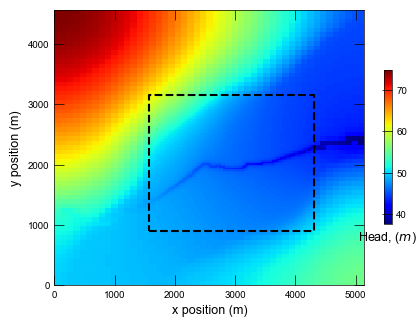This page was generated from
ex-gwf-lgrv.py.
It's also available as a notebook.
LGRV example
These are the models described in Vilhelmsen et al. (2012). The parent model is 9 layers, the child model is 25 layers.
Initial setup
Import dependencies, define the example name and workspace, and read settings from environment variables.
[1]:
import os
import pathlib as pl
import flopy
import flopy.utils.lgrutil
import git
import matplotlib.pyplot as plt
import numpy as np
import pooch
from flopy.plot.styles import styles
from modflow_devtools.misc import get_env, timed
# Example name and workspace paths. If this example is running
# in the git repository, use the folder structure described in
# the README. Otherwise just use the current working directory.
sim_name = "ex-gwf-lgrv"
try:
root = pl.Path(git.Repo(".", search_parent_directories=True).working_dir)
except:
root = None
workspace = root / "examples" if root else pl.Path.cwd()
figs_path = root / "figures" if root else pl.Path.cwd()
data_path = root / "data" / sim_name if root else pl.Path.cwd()
# Settings from environment variables
write = get_env("WRITE", True)
run = get_env("RUN", True)
plot = get_env("PLOT", True)
plot_show = get_env("PLOT_SHOW", True)
plot_save = get_env("PLOT_SAVE", True)
Define parameters
Define model units, parameters and other settings.
[2]:
# Model units
length_units = "meters"
time_units = "seconds"
# Scenario-specific parameters
parameters = {
"ex-gwf-lgrv-gr": {"configuration": "Refined"},
"ex-gwf-lgrv-gc": {"configuration": "Coarse"},
"ex-gwf-lgrv-lgr": {"configuration": "LGR"},
}
# Model parameters
nper = 1 # Number of periods
nlay = 25 # Number of layers in refined model
nrow = 183 # Number of rows in refined model
ncol = 147 # Number of columns in refined model
nlaygc = 9 # Number of layers in coarsened model
nrowcg = 61 # Number of rows in coarsened model
ncolcg = 49 # Number of columns in coarsened model
delr = 35.0 # Column width ($m$) in refined model
delc = 25.0 # Row width ($m$) in refined model
delv = 5.0 # Layer thickness ($m$) in refined model
delrgc = 105.0 # Column width ($m$) in coarsened model
delcgc = 75.0 # Row width ($m$) in coarsened model
delvgc = 15.0 # Layer thickness ($m$) in coarsened model
top_str = "variable" # Top of the model ($m$)
botm_str = "30 to -90" # Layer bottom elevations ($m$)
icelltype = 0 # Cell conversion type
recharge = 1.1098e-09 # Recharge rate ($m/s$)
k11_str = "5.e-07, 1.e-06, 5.e-05" # Horizontal hydraulic conductivity ($m/s$)
# Static temporal data used by TDIS file
# Simulation has 1 steady stress period (1 day)
perlen = [1.0]
nstp = [1]
tsmult = [1.0]
tdis_ds = list(zip(perlen, nstp, tsmult))
# load data files and process into arrays
fname = "top.dat"
fpath = pooch.retrieve(
url=f"https://github.com/MODFLOW-USGS/modflow6-examples/raw/master/data/{sim_name}/{fname}",
fname=fname,
path=data_path,
known_hash="md5:7e95923e78d0a2e2133929376d913ecf",
)
top = np.loadtxt(fpath)
ikzone = np.empty((nlay, nrow, ncol), dtype=float)
hashes = [
"548876af515cb8db0c17e7cba0cda364",
"548876af515cb8db0c17e7cba0cda364",
"548876af515cb8db0c17e7cba0cda364",
"548876af515cb8db0c17e7cba0cda364",
"d91e2663ad671119de17a91ffb2a65ab",
"1702d97a83074669db86521b22b87304",
"da973a8edd77a44ed23a29661e2935eb",
"0d514a8f7b208e840a8e5cbfe4018c63",
"afd45ac7125f8351b73add34d35d8435",
"dc99e101996376e1dde1d172dea05f5d",
"fe8d2de0558245c9270597b01070403a",
"cd1fcf0fe2c807ff53eda80860bfe50f",
"c77b43c8045f5459a75547d575665134",
"2252b57927d7d01d0f9a0dda262397d7",
"1399c6872dd7c41be4b10c1251ad7c65",
"331e4006370cceb3864b881b7a0558d6",
"a46e66e632c5af7bf104900793509e5d",
"41f44eee3db48234069de4e9e329317b",
"8f4f1bdd6b6863c3ba68e2336f5ff70a",
"a1c856c05bcc4a17cf3fe61b87fbc720",
"a23fef9e866ad9763943150a3b70f5eb",
"02d67bc7f67814d2248c27cdd5205cf8",
"e7a07da76d111ef2229d26c553daa7eb",
"f6bc51735c4af81e1298d0efd06cd506",
"432b9a02f3ff4906a214b271c965ebad",
]
for k in range(nlay):
fname = f"ikzone{k + 1}.dat"
fpath = pooch.retrieve(
url=f"https://github.com/MODFLOW-USGS/modflow6-examples/raw/master/data/{sim_name}/{fname}",
fname=fname,
path=data_path,
known_hash=f"md5:{hashes[k]}",
)
ikzone[k, :, :] = np.loadtxt(fpath)
fname = "riv.dat"
fpath = pooch.retrieve(
url=f"https://github.com/MODFLOW-USGS/modflow6-examples/raw/master/data/{sim_name}/{fname}",
fname=fname,
path=data_path,
known_hash="md5:5ccbe4f29940376309db445dbb2d75d0",
)
dt = [
("k", int),
("i", int),
("j", int),
("stage", float),
("conductance", float),
("rbot", float),
]
rivdat = np.loadtxt(fpath, dtype=dt)
rivdat["k"] -= 1
rivdat["i"] -= 1
rivdat["j"] -= 1
riv_spd = [[(k, i, j), stage, cond, rbot] for k, i, j, stage, cond, rbot in rivdat]
botm = [30 - k * delv for k in range(nlay)]
botm = np.array(botm)
k11_values = [float(value) for value in k11_str.split(",")]
k11 = np.zeros((nlay, nrow, ncol), dtype=float)
for i, kval in enumerate(k11_values):
k11 = np.where(ikzone == i + 1, kval, k11)
# Define model extent and child model extent
xmin = 0
xmax = ncol * delr
ymin = 0.0
ymax = nrow * delc
model_domain = [xmin, xmax, ymin, ymax]
child_domain = [
xmin + 15 * 3 * delr,
xmin + 41 * 3 * delr,
ymax - 49 * 3 * delc,
ymax - 19 * 3 * delc,
]
# Solver parameters
nouter = 50
ninner = 100
hclose = 1e-6
rclose = 100.0
Model setup
Define functions to build models, write input files, and run the simulation.
[3]:
def coarsen_shape(icoarsen, nrow, ncol):
nrowc = int(np.ceil(nrow / icoarsen))
ncolc = int(np.ceil(ncol / icoarsen))
return (nrowc, ncolc)
def create_resampling_labels(a, icoarsen):
nrow, ncol = a.shape
labels = np.zeros((nrow, ncol), dtype=int)
nodec = 0
for ic in range(0, nrow, icoarsen):
for jc in range(0, ncol, icoarsen):
labels[ic : ic + icoarsen, jc : jc + icoarsen] = nodec
nodec += 1
return labels
def array_resampler(a, icoarsen, method):
import scipy.ndimage as ndimage
assert method in ["mean", "minimum", "maximum", "sum"]
nrow, ncol = a.shape
nrowc, ncolc = coarsen_shape(icoarsen, nrow, ncol)
labels = create_resampling_labels(a, icoarsen)
idx = np.array(range(nrowc * ncolc))
if method == "mean":
ar = ndimage.mean(a, labels=labels, index=idx)
elif method == "minimum":
ar = ndimage.minimum(a, labels=labels, index=idx)
elif method == "maximum":
ar = ndimage.maximum(a, labels=labels, index=idx)
elif method == "sum":
ar = ndimage.sum(a, labels=labels, index=idx)
return ar.reshape((nrowc, ncolc))
def riv_resample(icoarsen, nrow, ncol, rivdat, idomain, rowcolspan):
stage_grid = np.zeros((nrow, ncol), dtype=float)
cond_grid = np.zeros((nrow, ncol), dtype=float)
rbot_grid = np.zeros((nrow, ncol), dtype=float)
count_grid = np.zeros((nrow, ncol), dtype=int)
for k, i, j, stage, cond, rbot in rivdat:
stage_grid[i, j] = stage
cond_grid[i, j] = cond
rbot_grid[i, j] = rbot
count_grid[i, j] += 1
stagec_grid = array_resampler(stage_grid, icoarsen, "sum")
condc_grid = array_resampler(cond_grid, icoarsen, "sum")
rbotc_grid = array_resampler(rbot_grid, icoarsen, "sum")
countc_grid = array_resampler(count_grid, icoarsen, "sum")
stagec_grid = np.divide(stagec_grid, countc_grid)
rbotc_grid = np.divide(rbotc_grid, countc_grid)
if rowcolspan is not None:
istart, istop, jstart, jstop = rowcolspan
stagec_grid = stagec_grid[istart:istop, jstart:jstop]
condc_grid = condc_grid[istart:istop, jstart:jstop]
rbotc_grid = rbotc_grid[istart:istop, jstart:jstop]
countc_grid = countc_grid[istart:istop, jstart:jstop]
rows, cols = np.where(condc_grid > 0.0)
rivdatc = []
for i, j in zip(rows, cols):
k = 0
if idomain[k, i, j] == 1:
rivdatc.append(
[
(k, i, j),
stagec_grid[i, j],
condc_grid[i, j],
rbotc_grid[i, j],
]
)
return rivdatc
def build_lgr_model(name):
sim_ws = os.path.join(workspace, name)
sim = flopy.mf6.MFSimulation(sim_name=name, sim_ws=sim_ws, exe_name="mf6")
flopy.mf6.ModflowTdis(sim, nper=nper, perioddata=tdis_ds, time_units=time_units)
flopy.mf6.ModflowIms(
sim,
outer_maximum=nouter,
outer_dvclose=hclose,
inner_maximum=ninner,
inner_dvclose=hclose,
rcloserecord=f"{rclose} strict",
)
# parent model with coarse grid
icoarsen = 3
ncppl = [1, 3, 3, 3, 3, 3, 3, 3, 3]
sim = build_parent_model(sim, name, icoarsen=icoarsen, ncppl=ncppl)
gwf = sim.get_model("parent")
# child model with fine grid
sim = build_child_model(sim, name)
gwfc = sim.get_model("child")
# use flopy lgr utility to wire up connections between parent and child
nlayp = len(ncppl)
nrowp = gwf.dis.nrow.get_data()
ncolp = gwf.dis.ncol.get_data()
delrp = gwf.dis.delr.array
delcp = gwf.dis.delc.array
topp = gwf.dis.top.array
botmp = gwf.dis.botm.array
idomainp = gwf.dis.idomain.array
lgr = flopy.utils.lgrutil.Lgr(
nlayp,
nrowp,
ncolp,
delrp,
delcp,
topp,
botmp,
idomainp,
ncpp=icoarsen,
ncppl=ncppl,
)
# swap out lgr child top and botm with
topc = gwfc.dis.top.array
botmc = gwfc.dis.botm.array
lgr.top = topc
lgr.botm = botmc
exgdata = lgr.get_exchange_data(angldegx=True, cdist=True)
flopy.mf6.ModflowGwfgwf(
sim,
nexg=len(exgdata),
exgtype="GWF6-GWF6",
exgmnamea="parent",
exgmnameb="child",
exchangedata=exgdata,
auxiliary=["angldegx", "cdist"],
)
return sim
def build_parent_model(sim, name, icoarsen, ncppl):
xminp, xmaxp, yminp, ymaxp = model_domain
xminc, xmaxc, yminc, ymaxc = child_domain
delcp = delc * icoarsen
delrp = delr * icoarsen
istart = int((ymaxp - ymaxc) / delcp)
istop = int((ymaxp - yminc) / delcp)
jstart = int((xminc - xminp) / delrp)
jstop = int((xmaxc - xminp) / delrp)
nrowp, ncolp = coarsen_shape(icoarsen, nrow, ncol)
nlayp = len(ncppl)
idomain = np.ones((nlayp, nrowp, ncolp), dtype=int)
idomain[:, istart:istop, jstart:jstop] = 0
sim = build_models(
name,
icoarsen=icoarsen,
ncppl=ncppl,
idomain=idomain,
sim=sim,
modelname="parent",
)
return sim
def build_child_model(sim, name):
icoarsen = 1
xminp, xmaxp, yminp, ymaxp = model_domain
xminc, xmaxc, yminc, ymaxc = child_domain
delcp = delc * icoarsen
delrp = delr * icoarsen
istart = int((ymaxp - ymaxc) / delcp)
istop = int((ymaxp - yminc) / delcp)
jstart = int((xminc - xminp) / delrp)
jstop = int((xmaxc - xminp) / delrp)
nrowp, ncolp = coarsen_shape(icoarsen, nrow, ncol)
sim = build_models(
name,
rowcolspan=[istart, istop, jstart, jstop],
sim=sim,
modelname="child",
xorigin=xminc,
yorigin=yminc,
)
return sim
def build_models(
name,
icoarsen=1,
ncppl=None,
rowcolspan=None,
idomain=None,
sim=None,
modelname=None,
xorigin=None,
yorigin=None,
):
if sim is None:
sim_ws = os.path.join(workspace, name)
sim = flopy.mf6.MFSimulation(sim_name=name, sim_ws=sim_ws, exe_name="mf6")
flopy.mf6.ModflowTdis(sim, nper=nper, perioddata=tdis_ds, time_units=time_units)
flopy.mf6.ModflowIms(
sim,
outer_maximum=nouter,
outer_dvclose=hclose,
inner_maximum=ninner,
inner_dvclose=hclose,
rcloserecord=f"{rclose} strict",
)
if modelname is None:
modelname = name
gwf = flopy.mf6.ModflowGwf(sim, modelname=modelname, save_flows=True)
if ncppl is not None:
nlayc = len(ncppl)
layer_index = [ncppl[0] - 1]
for iln in ncppl[1:]:
last = layer_index[-1]
layer_index.append(iln + last)
else:
nlayc = nlay
layer_index = list(range(nlayc))
nrowc, ncolc = coarsen_shape(icoarsen, nrow, ncol)
delrc = delr * icoarsen
delcc = delc * icoarsen
topc = array_resampler(top, icoarsen, "mean")
if rowcolspan is not None:
istart, istop, jstart, jstop = rowcolspan
nrowc = istop - istart
ncolc = jstop - jstart
else:
istart = 0
istop = nrow
jstart = 0
jstop = ncol
if idomain is None:
idomain = 1
topc = topc[istart:istop, jstart:jstop]
flopy.mf6.ModflowGwfdis(
gwf,
length_units=length_units,
nlay=nlayc,
nrow=nrowc,
ncol=ncolc,
delr=delrc,
delc=delcc,
top=topc,
botm=botm[layer_index],
idomain=idomain,
xorigin=xorigin,
yorigin=yorigin,
)
idomain = gwf.dis.idomain.array
k11c = []
for k in range(nlayc):
ilay = layer_index[k]
a = array_resampler(k11[ilay], icoarsen, "maximum")
k11c.append(a[istart:istop, jstart:jstop])
flopy.mf6.ModflowGwfnpf(
gwf,
k33overk=True,
icelltype=icelltype,
k=k11c,
save_specific_discharge=True,
k33=1.0,
)
strt = nlayc * [topc]
flopy.mf6.ModflowGwfic(gwf, strt=strt)
rivdatc = riv_resample(icoarsen, nrow, ncol, rivdat, idomain, rowcolspan)
riv_spd = {0: rivdatc}
flopy.mf6.ModflowGwfriv(
gwf,
stress_period_data=riv_spd,
pname="RIV",
)
flopy.mf6.ModflowGwfrcha(gwf, recharge=recharge, pname="RCH")
head_filerecord = f"{modelname}.hds"
budget_filerecord = f"{modelname}.cbc"
flopy.mf6.ModflowGwfoc(
gwf,
head_filerecord=head_filerecord,
budget_filerecord=budget_filerecord,
saverecord=[("HEAD", "ALL"), ("BUDGET", "ALL")],
)
return sim
def write_models(sim, silent=True):
sim.write_simulation(silent=silent)
@timed
def run_models(sim, silent=False):
success, buff = sim.run_simulation(silent=silent, report=True)
assert success, buff
Plotting results
Define functions to plot model results.
[4]:
# Figure properties
figure_size = (5, 4)
def plot_grid(sim):
with styles.USGSMap():
name = sim.name
gwf = sim.get_model("parent")
gwfc = None
if "child" in list(sim.model_names):
gwfc = sim.get_model("child")
fig = plt.figure(figsize=figure_size)
fig.tight_layout()
ax = fig.add_subplot(1, 1, 1, aspect="equal")
pmv = flopy.plot.PlotMapView(model=gwf, ax=ax, layer=0)
# pmv.plot_grid()
idomain = gwf.dis.idomain.array
tp = np.ma.masked_where(idomain[0] == 0, gwf.dis.top.array)
vmin = tp.min()
vmax = tp.max()
if gwfc is not None:
tpc = gwfc.dis.top.array
vmin = min(vmin, tpc.min())
vmax = max(vmax, tpc.max())
cb = pmv.plot_array(tp, cmap="jet", alpha=0.25, vmin=vmin, vmax=vmax)
pmv.plot_bc(name="RIV")
ax.set_xlabel("x position (m)")
ax.set_ylabel("y position (m)")
cbar = plt.colorbar(cb, shrink=0.5)
cbar.ax.set_xlabel(r"Top, ($m$)")
if gwfc is not None:
pmv = flopy.plot.PlotMapView(model=gwfc, ax=ax, layer=0)
_ = pmv.plot_array(
tpc,
cmap="jet",
alpha=0.25,
masked_values=[1e30],
vmin=vmin,
vmax=vmax,
)
pmv.plot_bc(name="RIV")
if gwfc is not None:
xmin, xmax, ymin, ymax = child_domain
ax.plot(
[xmin, xmax, xmax, xmin, xmin],
[ymin, ymin, ymax, ymax, ymin],
"k--",
)
xmin, xmax, ymin, ymax = model_domain
ax.set_xlim(xmin, xmax)
ax.set_ylim(ymin, ymax)
if plot_show:
plt.show()
if plot_save:
fpth = figs_path / f"{name}-grid.png"
fig.savefig(fpth)
def plot_xsect(sim):
print(f"Plotting cross section for {sim.name}...")
with styles.USGSMap():
name = sim.name
gwf = sim.get_model("parent")
fig = plt.figure(figsize=(5, 2.5))
fig.tight_layout()
ax = fig.add_subplot(1, 1, 1)
irow, icol = gwf.modelgrid.intersect(3000.0, 3000.0)
pmv = flopy.plot.PlotCrossSection(model=gwf, ax=ax, line={"column": icol})
pmv.plot_grid(linewidth=0.5)
hyc = np.log(gwf.npf.k.array)
cb = pmv.plot_array(hyc, cmap="jet", alpha=0.25)
ax.set_xlabel("y position (m)")
ax.set_ylabel("z position (m)")
cbar = plt.colorbar(cb, shrink=0.5)
cbar.ax.set_xlabel(r"K, ($m/s$)")
if plot_show:
plt.show()
if plot_save:
fpth = figs_path / f"{name}-xsect.png"
fig.savefig(fpth)
def plot_heads(sim):
print(f"Plotting results for {sim.name} ...")
with styles.USGSMap():
name = sim.name
gwf = sim.get_model("parent")
gwfc = None
if "child" in list(sim.model_names):
gwfc = sim.get_model("child")
fig = plt.figure(figsize=figure_size)
fig.tight_layout()
print(" Loading heads...")
layer = 0
head = gwf.output.head().get_data()
head = np.ma.masked_where(head > 1e29, head)
vmin = head[layer].min()
vmax = head[layer].max()
if gwfc is not None:
headc = gwfc.output.head().get_data()
vmin = min(vmin, headc.min())
vmax = max(vmax, headc.max())
print(" Making figure...")
ax = fig.add_subplot(1, 1, 1, aspect="equal")
pmv = flopy.plot.PlotMapView(model=gwf, ax=ax, layer=0)
cb = pmv.plot_array(
head, cmap="jet", masked_values=[1e30], vmin=vmin, vmax=vmax
)
ax.set_xlabel("x position (m)")
ax.set_ylabel("y position (m)")
cbar = plt.colorbar(cb, shrink=0.5)
cbar.ax.set_xlabel(r"Head, ($m$)")
if gwfc is not None:
pmv = flopy.plot.PlotMapView(model=gwfc, ax=ax, layer=0)
cb = pmv.plot_array(
headc, cmap="jet", masked_values=[1e30], vmin=vmin, vmax=vmax
)
xmin, xmax, ymin, ymax = child_domain
ax.plot(
[xmin, xmax, xmax, xmin, xmin],
[ymin, ymin, ymax, ymax, ymin],
"k--",
)
xmin, xmax, ymin, ymax = model_domain
ax.set_xlim(xmin, xmax)
ax.set_ylim(ymin, ymax)
if plot_show:
plt.show()
if plot_save:
fpth = figs_path / f"{name}-head.png"
fig.savefig(fpth)
def plot_results(sim, silent=True):
plot_grid(sim)
plot_xsect(sim)
plot_heads(sim)
Running the example
Define and invoke a function to run the example scenario, then plot results.
[5]:
def scenario(idx, silent=True):
key = list(parameters.keys())[idx]
params = parameters[key].copy()
if params["configuration"] == "Refined":
sim = build_models(key, modelname="parent")
elif params["configuration"] == "Coarse":
ncppl = [1, 3, 3, 3, 3, 3, 3, 3, 3]
sim = build_models(key, icoarsen=3, ncppl=ncppl, modelname="parent")
elif params["configuration"] == "LGR":
sim = build_lgr_model(key)
if write:
write_models(sim, silent=silent)
if run:
run_models(sim, silent=silent)
if plot:
plot_results(sim, silent=silent)
Run the global refined model and plot results.
[6]:
scenario(0)
<flopy.mf6.data.mfstructure.MFDataItemStructure object at 0x7fb5c36a1ca0>
run_models took 28713.95 ms
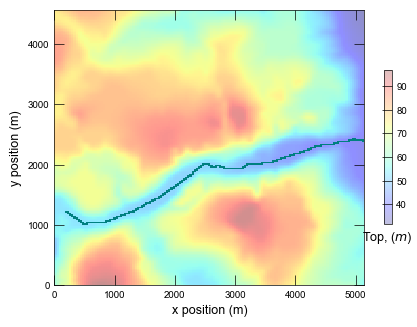
Plotting cross section for ex-gwf-lgrv-gr...
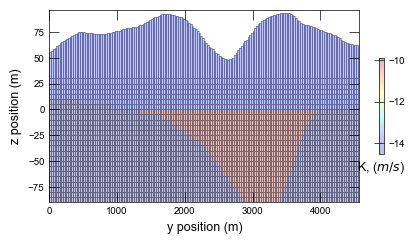
Plotting results for ex-gwf-lgrv-gr ...
Loading heads...
Making figure...
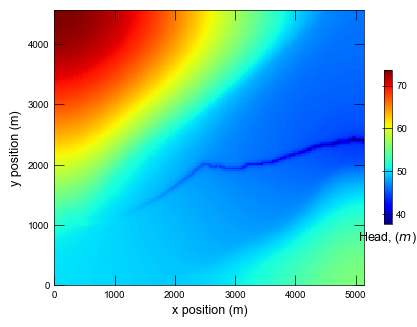
Run the global coarse model and plot results.
[7]:
scenario(1)
<flopy.mf6.data.mfstructure.MFDataItemStructure object at 0x7fb5c36a1ca0>
run_models took 375.58 ms
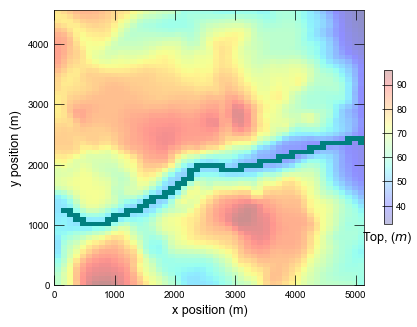
Plotting cross section for ex-gwf-lgrv-gc...
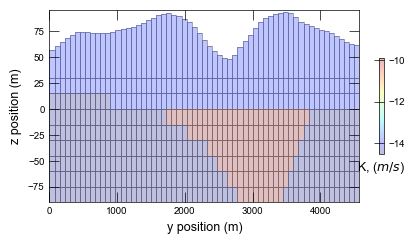
Plotting results for ex-gwf-lgrv-gc ...
Loading heads...
Making figure...
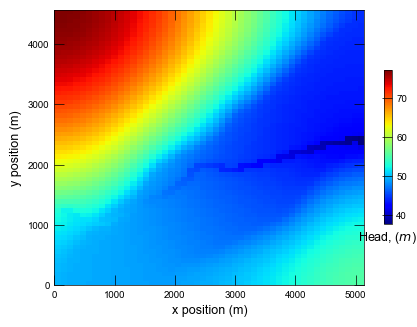
Run the locally refined grid model and plot results.
[8]:
scenario(2)
<flopy.mf6.data.mfstructure.MFDataItemStructure object at 0x7fb5c36a1ca0>
run_models took 7399.33 ms

Plotting cross section for ex-gwf-lgrv-lgr...
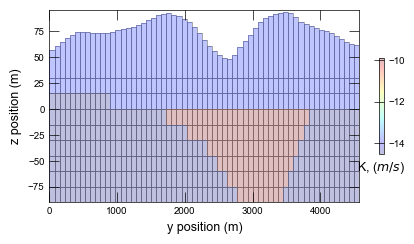
Plotting results for ex-gwf-lgrv-lgr ...
Loading heads...
Making figure...
